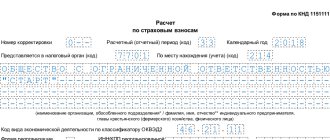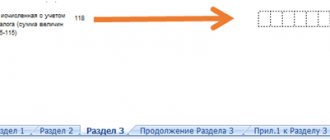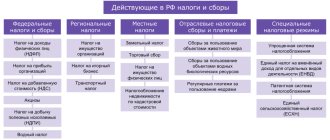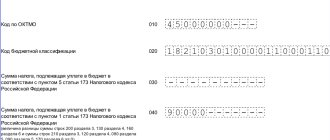Who is required to file mineral extraction tax reports?
Accountable persons are taxpayers extracting mineral resources under a license. As soon as an organization or individual entrepreneur receives a licensing document, it begins to submit monthly mineral extraction tax reports. The obligation to report to regulatory authorities begins from the month in which the extraction of resources actually began (Part 1 of Article 345 of the Tax Code of the Russian Federation).
IMPORTANT!
The regulatory documents of the Federal Tax Service indicate whether it is necessary to submit a tax return on mineral extraction tax if the taxpayer has temporarily suspended the extraction of resources - yes, the report must be submitted even if mining activities are suspended (letter of the Federal Tax Service No. SD-4-3 / [email protected] dated 21.08. 2020). While the license for subsoil development is valid, report monthly.
If organizations or individual entrepreneurs are temporarily not engaged in the extraction of mineral resources, they generate zero reporting. Along with the zero mineral extraction tax declaration, a covering letter is submitted explaining the zero indicators in the report.
Mineral extraction tax: general information
Mined minerals can be divided into the following groups:
- flammable substances (coal, peat, shale);
- hydrocarbon products, which include oil and produced gas with methane;
- ore;
- various types of non-metallic raw materials extracted by mining and mining chemical enterprises;
- Mineral extraction tax is also charged on rare metals;
- colored stones;
- quartz raw materials;
- precious and semi-precious metals, stones;
- salt;
- water for medicinal purposes and industrial, extracted from underground or natural, thermal springs.
The full list is specified in Art. 337 Tax Code of the Russian Federation. The object of taxation of mineral extraction tax is the volume of mineral resources extracted on the territory of the Russian Federation and abroad (Article 336 of the Tax Code of the Russian Federation). Raw materials obtained from sources that are not registered with the state and are not on balance sheet for government agencies are not subject to taxation. Raw materials from this category of subsoil can be extracted by an entrepreneur to meet his own needs.
When and where to submit a mineral extraction tax declaration
Mineral extraction tax reporting is submitted to the territorial inspectorate of the Federal Tax Service - at the place of registration of the organization or place of residence of the individual entrepreneur (clause 2 of article 345 of the Tax Code of the Russian Federation). There are also deadlines for submitting a mineral extraction tax declaration - before the last day of the month following the reporting month (clause 3 of Article 345 of the Tax Code of the Russian Federation).
Deadlines for submitting mineral extraction tax reports in 2021:
| Reporting period - month | Deadline for filing a mineral extraction tax declaration |
| December 2020 | 02/01/2021 (01/31/2021 - Sunday) |
| January 2021 | 03/01/2021 (02/28/2021 - Sunday) |
| February | 31.03.2021 |
| March | 30.04.2021 |
| April | 31.05.2021 |
| May | 30.06.2021 |
| June | 08/02/2021 (07/31/2021 - Saturday) |
| July | 31.08.2021 |
| August | 30.09.2021 |
| September | 01.11.2021 (31.10.2021 - Sunday) |
| October | 30.11.2021 |
| November | 01/10/2022 (12/31/2021 is a non-working day) |
| December 2021 | 31.01.2022 |
Deadlines for settlements with the budget
Tax must be paid to the federal budget no later than the 25th day of the month following the reporting period. That is, no later than January 25, 2020 for 2021 obligations.
IMPORTANT!
The taxpayer's obligations to the budget arise in the reporting period in which mining activities began. For example, if the start of activity occurs in the middle of the calendar year, then you will still have to report for this period.
KND form 1151054, sample filling
What form should I use to report?
For the period from January to March 2021, taxpayers submit a mineral extraction tax report on a form approved by Federal Tax Service Order No. ММВ-7-3/ [email protected] dated 12/20/2018. As of reporting for April 2021, a new form of declaration for mineral extraction tax is in effect, taking into account the regional coefficient, enshrined in the order of the Federal Tax Service of Russia No. KCh-7-3 / [email protected] dated 12/08/2020.
IMPORTANT!
The mineral extraction tax declaration for March 2021 is submitted on the old form by 04/30/2021. Mineral extraction tax reporting for April 2021 must be submitted in a new way. The deadline for submitting the April declaration on the new form is 05/31/2021.
The report is submitted in paper or electronic form. Taxpayers with up to 100 employees have the right to choose the delivery method. If the organization employs more than 100 people, then the declaration will have to be submitted electronically.
Delivery methods
The mineral extraction tax declaration can be submitted to the inspection:
- on paper (for example, through an authorized representative of the organization or by mail);
- in electronic form via telecommunication channels. If the average number of employees for the previous year (in newly created or reorganized organizations - for the month of creation or reorganization) exceeds 100 people, then this year you can submit tax returns only in this way. This also applies to organizations that are classified as the largest taxpayers. They must submit tax reports (including annual returns) electronically via telecommunications channels to interregional inspectorates for the largest taxpayers.
This is stated in paragraph 3 of Article 80 of the Tax Code of the Russian Federation.
Attention: failure to comply with the established method of submitting tax reports electronically will result in tax liability. The fine is 200 rubles. for every violation. This is stated in Article 119.1 of the Tax Code of the Russian Federation.
How to fill out a report
Mineral reporting consists of a title page and eight sections. The general rules for filling out a mineral extraction tax declaration are as follows:
- This is monthly information. Information is provided based on actual performance indicators for each month, and not on an accrual basis for the year.
- Taxpayers report on the use of the resources they actually extract. All other sections are not submitted to the Federal Tax Service.
- Information is sent only for natural resources with a completed production cycle. If on the date of the declaration the mineral is in development, it is not shown in the reporting.
- Mandatory sections to fill out are the title page and section 1 “Amount of tax to be paid to the budget.” The remaining blocks of the declaration are formed only during the actual extraction of a particular resource.
- The pages in the report are numbered in order. If you fill out the form on paper by hand, do not go beyond the margins and do not use a proofreader.
Step-by-step instructions on how to fill out a MET declaration for sand mining for taxpayers:
Step 1. Design the title page. We must indicate:
- TIN, checkpoint;
- correction number (for the primary form set to 0);
- tax authority code and location code;
- tax period (month) and reporting year;
- contact number;
- the number of completed pages in the declaration and the number of pages in accompanying documents;
- FULL NAME. manager or representative of the taxpayer, his signature and date of filling out the report.
Step 2. Enter information in section 1.
In this part, indicate the budget classification code for paying the tax, the amount of the mineral extraction tax contribution to be transferred and OKTMO at the location of the taxpayer.
IMPORTANT!
The BCC, location identifier and tax amount payable are filled in for each natural resource mined by the taxpayer.
Step 3. Fill out section 3.
This block is not intended for all taxpayers, but only for those organizations that produce oil. Prepare samples of declarations on industrial safety in oil fields for each subsoil site.
Step 4. Enter information in section 3.
In this part, reporting information is provided by gas producers. The production of natural combustible gas and gas condensate is taken into account, with the exception of the production of hydrocarbons in a new offshore field.
Step 5. In section 4, information is provided by hydrocarbon producers in new offshore fields. The license number, name of the deposit and the year of commencement of industrial production are entered.
Step 6. Forming section 5. This section is intended for those who extract the main types of resource. The report must indicate the code of the type of mineral. For our example - construction sand - code 10008 (Appendix No. 2 to Order No. MMV-7-3/827). Here's what else you need to specify:
- KBK for tax payment;
- unit of measure code for the extracted resource;
- tax rate.
Part 5.1 reflects the main characteristics of production - OKTMO, license number, amount of raw materials extracted. Block 5.2 provides tax calculation based on production indicators.
Step 7. We enter information into section 6. It determines the cost of a unit of extracted natural resource at an estimated cost. The taxpayer cites direct and indirect costs for the extraction of all types of raw materials developed by him.
IMPORTANT!
Section 6 is always the same, no matter how many natural resources the organization produces or develops. All expenses are accumulated in this block.
Step 8. Fill out section 7. This block is filled out only by coal miners.
Step 9. We complete filling out the declaration. We reflect the information in section 8. It records the indicators by which the additional tax on the production of dehydrated, desalted and stabilized oil is calculated.
General tax provisions
Features of the application of federal tax, rates, benefits, deadlines for submitting mineral extraction tax in 2021 are regulated in Chapter 26 of the Tax Code of the Russian Federation.
In addition to the Tax Code of the Russian Federation, key conditions are presented in the Law of the Russian Federation of February 21, 1992 No. 2395-1 “On Subsoil”. According to these regulations, taxpayers are recognized as all economic entities that are officially recognized as users of subsoil. Moreover, companies located in Crimea and Sevastopol are also classified as taxpayers of mineral extraction tax.
The tax base is recognized as minerals that:
- mined in Russia;
- received outside the Russian Federation, in territories leased under international treaties (contracts, agreements);
- extracted from some type of waste, which are subject to separate licensing.
IMPORTANT!
The company is required to register within 30 calendar days from the date of receipt of official permission (license). In other words, the organization has one calendar month to register. Otherwise, penalties will be applied to the company.
Features of the application of legislative norms regarding the mineral extraction tax are in a separate material “MET”.
General filling procedure
Mandatory inclusion in the declaration are the title page and sections for which the organization has the appropriate indicators to fill out. If the organization did not carry out transactions for which data should be reflected in one section or another, these sections do not need to be submitted (clause 2.3 of the Procedure).
For example, fill out section 6 only if, when determining the tax base, the value of the extracted mineral resource was assessed using a calculation method, and section 7 - if the organization calculates the mineral extraction tax for coal mining and uses a tax deduction.
This is stated in paragraphs 1.1 and 2.3 of the Procedure approved by order of the Federal Tax Service of Russia dated May 14, 2015 No. ММВ-7-3/197.
Reflect the cost indicators in the declaration taking into account the established format of the cells. If the lines provide for division into whole and fractional parts, enter the indicators in rubles and kopecks. If there is no such division, indicate the values of cost indicators in full rubles. Indicator values are less than 50 kopecks. throw it away, and 50 kopecks. or more, round up to the full ruble.
The fields of the declaration must be filled out from left to right, starting from the first (left) acquaintance. For negative numbers, indicate the “-” (minus) sign in the first sign on the left. If the declaration is filled out using software, then the values of the numerical indicators are aligned to the right (last) space.
Regardless of the number of sections to be filled out, the declaration uses continuous page numbering (starting from the title page). The page serial number is indicated from left to right starting from the first (left) character (for example, “033” for the thirty-third page).
Each declaration indicator corresponds to one field intended for a certain number of characters.
The return may not correct errors by correction or other similar means. In addition, double-sided printing of the declaration and binding of sheets, which leads to damage to the paper medium, are prohibited.
Such rules are established by clauses 2.2 and 2.3 of the Procedure approved by order of the Federal Tax Service of Russia dated May 14, 2015 No. ММВ-7-3/197.
Section 2
Section 2 “Data serving as the basis for the calculation and payment of tax for the production of dehydrated, desalted and stabilized oil, with the exception of production at a new offshore hydrocarbon field,” fill out separately for oil produced at each subsoil plot provided to the organization for use.
When filling out section 2, please indicate:
- on line 020 – BCC for mineral extraction tax on oil;
- on line 030 – code of the unit of measurement of the amount of oil produced “168” according to OKEI, in accordance with Appendix 4 to the Procedure approved by order of the Federal Tax Service of Russia dated May 14, 2015 No. ММВ-7-3/197;
- on line 040 – OKTMO, on the territory the organization pays the mineral extraction tax on the oil produced;
- on line 050 – series, number and type of license for the use of subsoil. For example, STV 12345 NE;
- on line 060 – the value of the indicator that characterizes the features of oil production (Dm);
- on line 070 – the value of the Kndpi indicator;
- on line 080 – the value of the coefficient characterizing the dynamics of world oil prices (Kts);
- on line 090 – the value of the coefficient characterizing the degree of depletion of reserves of the subsoil site (Kv);
- on line 100 - the degree of depletion of reserves of the subsoil area (Sv), calculated in order to determine the coefficient Kv;
- on line 110 – the value of the coefficient characterizing the amount of reserves of a specific subsoil plot (Kz);
- on line 115 – the value of the coefficient characterizing the degree of depletion of a specific hydrocarbon deposit (Kdv);
- on line 120 – the value of the coefficient characterizing the region of production and the properties of oil (Kkan);
- on line 130 – the amount of mineral extraction tax on oil extracted at the subsoil site, calculated in accordance with subclause 5.5.11 of clause 5.5 of the Procedure;
- on line 130 – the amount of mineral extraction tax calculated in accordance with subclause 5.5.11 of clause 5.5 of the Procedure;
- on line 140 – the amount of tax deduction (if there is none, then zero);
- on line 150, indicate the amount of tax calculated as the difference between lines 130 and 140.
Fill out subsections 2.1.1 and 2.1.2 of section 2 of the declaration in accordance with clauses 5.6 and 5.7 of the Procedure approved by order of the Federal Tax Service of Russia dated May 14, 2015 No. ММВ-7-3/197.
Such rules are established by clauses 5.1–5.8 of the Procedure approved by order of the Federal Tax Service of Russia dated May 14, 2015 No. ММВ-7-3/197.
Section 6
Section 6 “Determination of the cost of a unit of extracted mineral resources based on the estimated cost” should be completed for minerals for which the tax base is determined based on their estimated cost. Fill out this section in a single copy, regardless of the number of mined minerals, the value of which is estimated in the specified way.
When filling out section 6, please indicate:
- on lines 010-040 - data for calculating direct expenses related to mineral resources extracted in the tax period;
- on lines 050-090 - data for calculating indirect and other expenses related to mineral resources extracted in the tax period;
- on line 100 - the amount of expenses on lines 040 and 090;
- on line 110 - code of the unit of measurement of the amount of extracted minerals according to OKEI in accordance with Appendix 4 to the Procedure, approved by order of the Federal Tax Service of Russia dated May 14, 2015 No. ММВ-7-3/197;
- in column 1 - the code of the extracted mineral in accordance with Appendix 2 to the Procedure, approved by order of the Federal Tax Service of Russia dated May 14, 2015 No. ММВ-7-3/197;
- in column 2 - the amount of extracted minerals, the code of which is reflected in column 1;
- in column 3 - the share of the extracted mineral resource in the total amount of extracted mineral resources. It is defined as the ratio of the value in column 2 for a given mineral to the sum of the values in all lines of column 2;
- in column 4 - the amount of expenses for the extraction of minerals. It is defined as the product of the total amount of expenses for the extraction of mineral resources incurred in the tax period (line 100) and the share of the extracted mineral resource in the total amount of extracted mineral resources (column 3).
Such rules are established by clauses 9.1–9.5 of the Procedure approved by order of the Federal Tax Service of Russia dated May 14, 2015 No. ММВ-7-3/197.
Mineral extraction tax in the Republic of Kazakhstan
Kazakhstan is more loyal to the extraction of natural resources in its republic than the Russian government. Thus, the main changes in the mineral extraction tax in the Republic of Kazakhstan occurred in the following:
- Cancellation of some taxes. From 01/01/19, the government of the Republic of Kazakhstan will exclude the commercial discovery bonus. As of 01/01/18, payments for compensation of historical waste were canceled for companies that operate under a license issued before 12/31/2017, and from this date the duty on excess profits for oil workers was also eliminated.
- A signing bonus has become mandatory. Now it is paid without any benefits.
- Starting from the current year, the calculation of the mineral extraction tax in the Republic of Kazakhstan takes place per unit volume of the resource received, using the monthly price tag established by law for the current tax period.
The changes are effective from January 1, 2021. The mining industry contributes well to the growth of profits in the Russian budget due to increased rates for subsoil use and the sale of obtained resources. Therefore, the government is developing a “competent” mechanism to extract more tax at an increased rate from enterprises.





